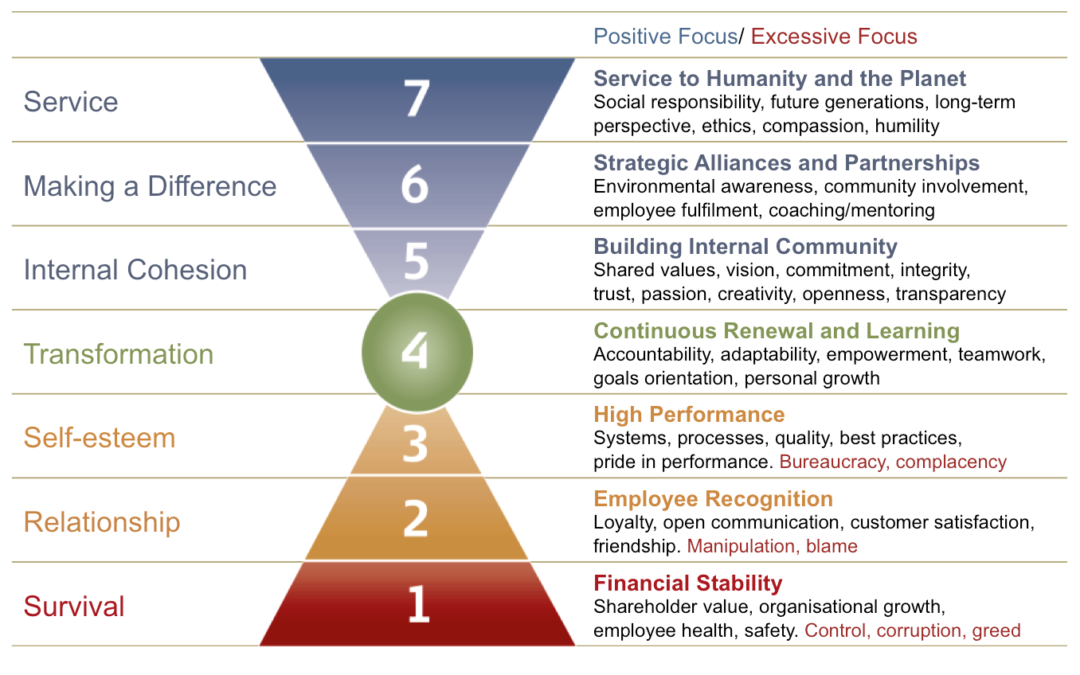You’ve likely seen the statistics… AON says 65% of employees globally are engaged (that means 35% are not); Gallup says 87% of the world’s employees are not engaged. Some of these global and national studies also provide generic ways to increase engagement. But something has always bothered me about employee engagement surveys. How do we know that what we’re measuring is a true reflection of how engaged our workforce is? Different people want different things from work, and in my experience, the same engagement tactics don’t work everywhere. Certainly, there are some broad and general strokes that can help – recognition for great work, opportunities to connect with colleagues, and meaningful work. But I would love to get more data about what is getting in people’s way of getting their best work done, and what they want more of or less of at work, in order to move the organization forward.
When I was introduced to Barrett Values Centre’s Culture Transformation Tools, I was skeptical at first. The survey is quick – 5 minutes, maybe 10 tops, if someone is extremely analytical. It asks three simple questions: What Values or behaviours are important to you personally; What Values or behaviours do you currently experience at work; and what Values or behaviours are important for your organization’s future success? Respondents select the top 10 for each response. I questioned whether truly relevant data could come of this, with words being somewhat ambiguous and with a long list of 80+ words to choose from.
But some of the most strategic, culture-passionate leaders I knew were using these tools… so I jumped in and got certified with Barrett Values Centre earlier this year. Then I tried the survey with a few clients and WOW!
The amount of actionable information in this simple tool is fabulous.It measures “Cultural Entropy”, which is “the degree of dysfunction (friction and frustration) in an organization or any human group structure (community or nation) that is generated by the self-serving, fear-based actions of the leaders.” Entropy is directly related to employee engagement. In fact, in 2008, Barrett and Hewitt Associates took part in a collaborative project to compare levels of engagement to levels of entropy, and found that they were inversely correlated – organizations with lower entropy had higher engagement and vice versa. Not only does the Barrett culture survey provide the level of Entropy, it makes it clear immediately what is limiting people’s performance, and what they are asking for as an “antidote” to the problems they’re facing. It also shows where the organization’s focus is in general and where people believe it should be for future success.
Some of the insights we’ve gained in our first 4 months of using Barrett’s Culture Transformation Tools:
- In one company, we found that the three leaders had quite different values systems, and that their teams were experiencing very separate and distinct cultures themselves.
- In another organization, we found that the focus of the organization had been on high performance systems and processes, and the people were saying “enough already!” Quality and systems are now a given, we want to focus on leadership, culture, and soft skills.
- In a multi-location firm we found the lowest entropy in the location where people’s personal and current values were very similar, showing that when people are able to bring themselves to work fully, they are more engaged and productive.
- In a recently merged company, we saw extremely high entropy in the division that had been acquired, but so many shared personal values across all divisions that we now have a great starting point to build strong, positive culture together.
- In all cases, we gained clarity about what was limiting people’s performance (things like control, caution, information hoarding, bureaucracy, silo mentality and more) and what they were requesting to resolve these issues.
 So here’s a little intro to the Barrett Values Model. The Model was created 19 years ago by Richard Barrett, author of several books, the most relevant to this being “The Values-Driven Organization.” It is based on Maslow’s hierarchy of needs, which you’ve probably heard of. In very basic terms, Maslow saw people’s motivation changing based on their needs, with basic survival needs like food, water and shelter being at the bottom of the hierarchy and higher level needs such as esteem and self actualization being at the top. Maslow’s theory was that people’s lower level needs must be met before they would be highly motivated by higher level needs.
So here’s a little intro to the Barrett Values Model. The Model was created 19 years ago by Richard Barrett, author of several books, the most relevant to this being “The Values-Driven Organization.” It is based on Maslow’s hierarchy of needs, which you’ve probably heard of. In very basic terms, Maslow saw people’s motivation changing based on their needs, with basic survival needs like food, water and shelter being at the bottom of the hierarchy and higher level needs such as esteem and self actualization being at the top. Maslow’s theory was that people’s lower level needs must be met before they would be highly motivated by higher level needs. 
Barrett’s Seven Levels are similar, but results from thousands of organizations show that the most sustainably successful organizations actually operate across levels – what Barrett calls “full spectrum.” In other words, they don’t forget about financial values in their focus on making a difference in the world. The Values model has 7 levels, and can be geared to personal, leadership, organizational, or societal culture.
You can see how at the lower levels (1,2, and 3), there are red words within the focus areas, which represent excessive focus. We call these “potentially limiting” values, as they can limit an employee’s performance and an organization’s results. These limiting values contribute to the entropy score, thus highlighting what is causing disengagement amongst employees.
These tools are truly transformational and we are loving our work with them so far.
If you want a little taste, you can even do a free Personal Values Assessment over on the Barrett Values Centre website. We’d love to hear what you learn about yourself! Tweet to us (@bluerebelworks) using #liveyourvalues or share your insight with us on our Facebook page!


Recent Comments